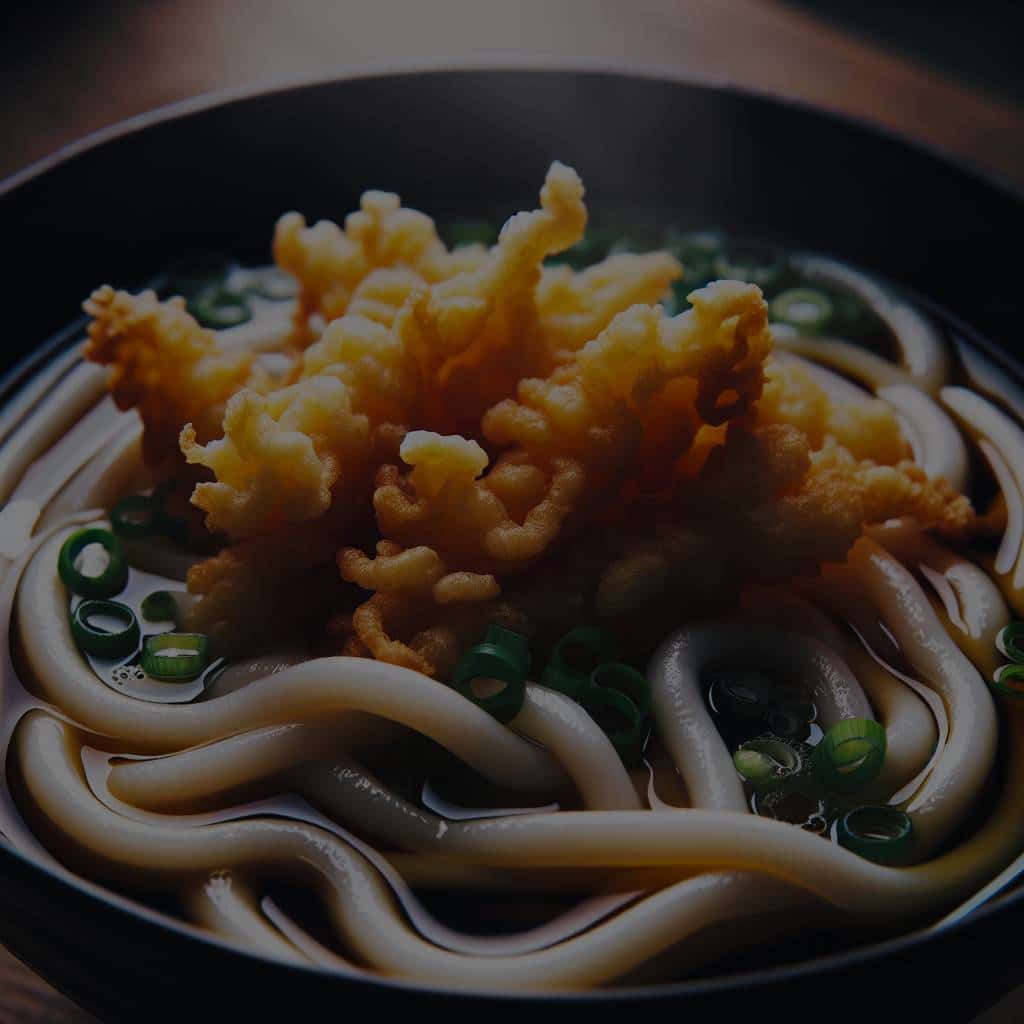What’s the Key to a Perfectly Crisp and Tender Japanese Tempura Udon?

If you have ever wondered why your homemade Tempura Udon doesn’t quite match up to the one you had at your favorite Japanese restaurant, then you are in the right place. In this article, we will share the secrets to mastering this versatile, deeply satisfying dish. We explore everything from achieving the perfect batter crunch for your tempura to the soothing warmth of a well-made udon soup. The aim is to reveal the fine balance of flavors and texture that marks an authentic Tempura Udon.
Achieving the Perfect Tempura Batter
Tempura is a popular Japanese dish that uses a light, airy batter to coat ingredients like shrimp, vegetables, and even chicken. The resulting dish is crisp, delicate, and perfect for dipping in a flavorful sauce.
Lire également : How to Craft a Gourmet Gravlax with Dill and Mustard Sauce at Home?
Mastering the tempura batter is crucial to achieving the right consistency and crunch. The batter’s core ingredients typically include flour, egg, and iced water. However, the key to a standout tempura lies in the batter’s consistency and temperature.
Make sure that the batter is ice cold, as this aids in achieving the signature crispness. The flour should be combined with very cold water, and then the egg lightly beaten into it. But remember, never over mix. Aim for a slightly lumpy mixture; this helps to create a diverse texture in the final product.
A découvrir également : Can You Recreate an Authentic Greek Gyro with Homemade Tzatziki Sauce?
Another tip is to use soda water instead of regular water, as the carbonation can help to lighten the batter. For the flour, some chefs swear by using rice flour or adding a bit of cornstarch to give the tempura that extra crunch.
Choosing the Right Ingredients for Tempura
The beauty of tempura lies in its versatility. You can use a wide variety of ingredients, from shrimp and chicken to a plethora of vegetables.
When it comes to shrimp, look for medium-sized ones, as they tend to fry up nicely and offer a satisfying bite. For the vegetables, seasonal offerings are always a great choice. This could be anything from sweet bell peppers and zucchini in the summer to earthy mushrooms and hearty sweet potatoes in the winter.
To prepare your ingredients for the tempura, clean and dry them thoroughly. Then, lightly dust them with flour before dipping them into the batter. This helps the batter adhere to the ingredients and results in a more uniform coating.
Mastering the Art of Frying Tempura
It can be daunting to fry tempura at home, especially if you’re not used to frying. However, with the right preparation and technique, this task becomes quite manageable.
The key lies in the oil used and the temperature at which the tempura is fried. Opt for a neutral oil like vegetable or canola, which will not add any unwanted flavor to your tempura. The oil should be heated to around 170-180 degrees Celsius.
Once the oil is hot enough, carefully dip your battered ingredients into it. Let them fry until they develop a golden-brown color, which usually takes around 2-3 minutes. Turn your ingredients occasionally to ensure they cook evenly.
Crafting the Perfect Udon Soup
Udon noodles are a staple in Japanese cuisine. They’re thick, chewy, and incredibly satisfying. But what sets a good udon soup apart from a great one is the soup base itself.
Start with a simple dashi — a common Japanese soup base — made from kombu (seaweed) and bonito flakes. Add to this a blend of soy sauce, mirin, and a bit of sugar to create a rich, umami-filled broth that perfectly complements the udon noodles.
When it comes to cooking the noodles, make sure to follow the package instructions. Udon noodles should be chewy and not too soft. Once cooked, plunge them into ice water to stop the cooking process and to ensure they maintain their texture.
Bringing it all Together: Tempura Udon
Now that you’ve mastered the individual components, it’s time to bring them together.
Start by placing your cooked udon noodles in a bowl. Ladle over the warm soup, making sure the noodles are well coated. Arrange your crispy tempura on top of the noodles. If you have it, a sprinkling of finely chopped green onions or grated daikon radish adds a nice touch to the dish.
Remember, the tempura should be served immediately after frying to maintain its crispness. The contrast between the tender udon noodles, warm soup, and the crunchy tempura is what makes this dish such a delight to the senses.
A perfectly made Tempura Udon is a symphony of textures and flavors. It is a testament to the simplicity and subtlety that are often the hallmarks of Japanese cuisine. With these tips and techniques up your sleeve, you will be well on your way to crafting a Tempura Udon that is both satisfying and authentic. Happy cooking!
Crafting the Perfect Tempura Dipping Sauce
No tempura dish would be complete without a well-made dipping sauce. The dipping sauce for tempura, also known as Tentsuyu, is traditionally a combination of dashi, soy sauce, and mirin. These ingredients combine to make a sauce that is both savory and slightly sweet, with a depth of flavor that pairs perfectly with the light, crispy tempura.
Start by combining equal parts of dashi, mirin, and soy sauce in a saucepan. Gently heat the mixture over medium heat until it begins to simmer. Once it starts simmering, reduce the heat to low and let the sauce cook for about 3-5 minutes. This will allow the flavors to meld together and create a rich, delicious dipping sauce.
However, be careful not to overcook the sauce as it can become too strong and overpower the delicate flavors of the tempura. After the sauce has cooked, let it cool and then strain it to remove any bits of dashi or other ingredients. The sauce should be clear and smooth, ready to enhance your tempura’s flavor.
You can also add a bit of grated daikon radish or ginger to the sauce for an extra layer of flavor. These additions provide a refreshing contrast to the rich, deep flavors of the sauce and the tempura.
Conclusion: Revelling in the Craft of Tempura Udon
Creating the perfect Tempura Udon is truly an art form. It requires patience, precision and a keen understanding of the ingredients and techniques involved. From achieving the right crunch in your tempura, to creating a rich and flavorful udon soup, each component plays a crucial role in the final dish.
The magic of Tempura Udon lies in its balance of textures and flavors. The crispy, delicate tempura shrimp, chicken or vegetable provides a delightful contrast to the thick, chewy udon noodles. These components are brought together by a rich, umami-filled noodle soup, and enhanced with a deeply flavorful dipping sauce.
However, don’t forget that the beauty of cooking is in the process, not just the final outcome. The journey of crafting each component, and the joy of bringing them together into a cohesive, mouth-watering dish, is what makes cooking such a rewarding experience.
Now that you have all the tools and techniques at your disposal, it’s time to embark on your own Tempura Udon making adventure. Remember, it’s not just about recreating a traditional Japanese dish, but about making it your own. So, don’t be afraid to experiment with different ingredients and flavors.
Finally, remember that the secret to a great Tempura Udon is in the details. Paying attention to the small things, like the temperature of the batter or the consistency of the udon noodle soup, can make a huge difference. And remember, practice makes perfect. So keep trying, keep tasting, and soon enough, you’ll be able to create a Tempura Udon that rivals your favorite Japanese restaurant’s. Happy cooking!
